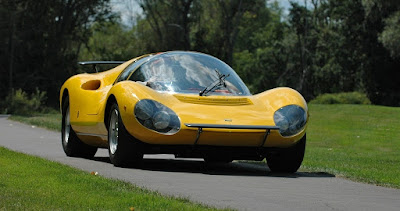As a true automotive lover, of course, You know the figure of the first Italian sports car which is launched in 1946 by the Compagnia Industriale Sportiva Italia (Cisitalia) and said with a little help from Pinin Farina.
 |
| 2012 Cisitalia 202 E by the design students of the Master of Arts in Transportation Design program in the academic year of 2010/2011 of the Istituto Europeo di Design (IED). (Picture from: https://bit.ly/34tC0Oj) |
The car named Cisitalia 202 was first unveiled at Lake Como's Villa d'Este Gold Cup in 1947 before it was showcased at the Paris Auto Show that same year. This car was never produced on a large scale, only a few examples were made as many as 170 units.
Then what if the legendary car figure gets a chance to be reborn and of course with a modern interpretation? This is what the design students of the Master of Arts in Transportation Design program in the academic year of 2010/2011 of the Istituto Europeo di Design (IED), a Tutin-based design school to make a modern interpretation of the classic car mentioned above and later called as 2012 Cisitalia 202 E. In this case, the “E” in the title stands for evolution.
 |
| 2012 Cisitalia 202 E while sat on display at the 82nd Geneva International Motor Show in 2012. (Picture from: https://bit.ly/34tC0Oj) |
According to IED, the concept faithfully reflects the design of the historic vehicle, with dimensions and power aligned with modern times. Technical partners of the project include CECOMP (prototype construction), Pirelli, OZ Racing, and ABET Laminati.
 |
| The concept car created by design students from IED Turino is a modern interpretation of the 1947 Cisitalia 202 GT by Pinin Farina. (Picture from: https://bit.ly/3kBSgCE) |
The concept car was unveiled in the flesh at the 82nd Geneva International Motor Show in 2012. And the modern-day Cisitalia 202 concept is the work of eleven students of the Master course coordinated by Pininfarina Lead Designer Luca Borgogno and Maserati designer Luigi Giampaolo.
The idea for the Cisitalia 202 E came from Chen Chin-Hsuan from Taiwan, who was aided by Shaaz Abbasi Bin Saeed from India, Yaroslav Chumachenko from Ukraine, Yo Kobayashi from Japan, Vasily Kurkov from Russia, Andrea Leoncini, Daniela Spina, and Pasquale Meli from Italy, and Soowan Park and Yoon Seul Ki and Soohan Yun from Korea.
The two-seater Cisitalia 202 E coupe has 4,270 mm long, a width of 1,850 mm, 1,240 mm tall, and it rides on a 2,650 mm wheelbase. Furthermore, the concept gets an unspecified, compact V8 engine producing 450 bhp that is mounted up front driving the rear wheels.
While, the original 1947 Cisitalia was powered by a small displacement 1.1-liter inline four-cylinder engine delivering only 55 bhp at 5,500 rpm, but thanks to the coupe’s low kerb weight of just 780 kg (1,720 lbs), it propelled it to a top speed of 165 kph (102 mph).
The idea for the Cisitalia 202 E came from Chen Chin-Hsuan from Taiwan, who was aided by Shaaz Abbasi Bin Saeed from India, Yaroslav Chumachenko from Ukraine, Yo Kobayashi from Japan, Vasily Kurkov from Russia, Andrea Leoncini, Daniela Spina, and Pasquale Meli from Italy, and Soowan Park and Yoon Seul Ki and Soohan Yun from Korea.
 |
| 2012 Cisitalia 202 E is a two-seater coupe that has 4,270 mm long, a width of 1,850 mm, 1,240 mm tall, and it rides on a 2,650 mm wheelbase. (Picture from: https://bit.ly/34tC0Oj) |
"To encourage our students to overstep their limits, they must have the possibility of developing exciting, ambitious projects," said César Mendoza, Director of IED Turin.
"What greater challenge than to redesign one of the most beautiful cars in the world? An extraordinary opportunity. Taking advantage of this occasion and with the support of Cisitalia and the commitment of lecturers and coordinators, we have achieved outstanding results not only with regard to the life-size model of the vehicle but in all the projects proposed, making it extremely difficult to single out that to be presented in Geneva," Mendoza concluded. *** [EKA | FROM VARIOUS SOURCES | IED | SUPERCARS | CARBODYDESIGN | AUTOBLOG | CARSCOOPS]
Note: This blog can be accessed via your smart phone


















































